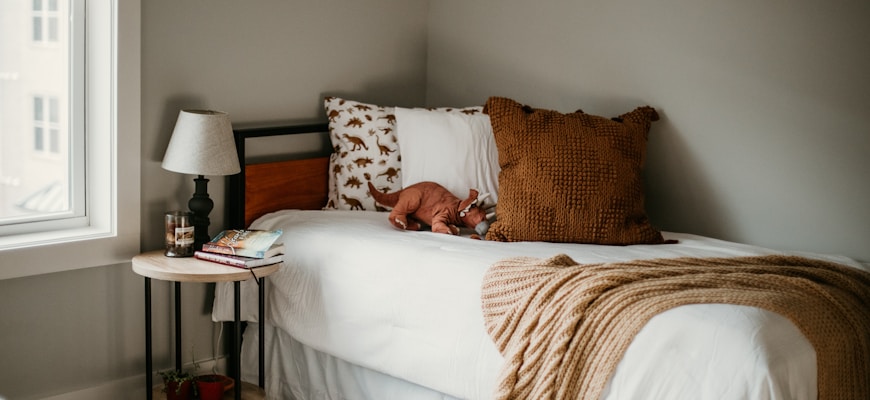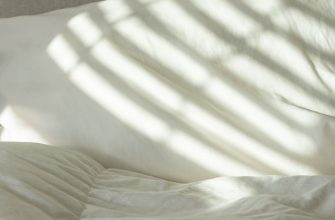- Transforming Your Bedroom into a Sanctuary for Sleep
- Essential Elements for a Restful Sleeping Environment
- The Role of Color and Lighting in Sleep Quality
- Tips for Choosing the Perfect Mattress and Bedding
- Incorporating Nature: Creating a Calming Atmosphere
- Decluttering Your Space: The Key to a Peaceful Sleep Haven
Transforming Your Bedroom into a Sanctuary for Sleep
Creating a tranquil and inviting bedroom environment is essential for enhancing sleep quality. A well-designed sleeping space acts as a sanctuary, promoting relaxation and restful slumber. The right elements can transform a standard bedroom into a personal retreat, fostering an atmosphere conducive to relaxation.
- Color Palette: Select calming colors such as soft blues, muted greens, or gentle grays. These hues create a serene ambiance that encourages relaxation and makes the bedroom feel more like a sanctuary.
- Lighting: Utilize soft, adjustable lighting options. Dimmable lights or bedside lamps with warm tones help create a peaceful atmosphere, perfect for unwinding at the end of the day.
- Bedding Choices: Invest in high-quality, breathable bedding. Natural fibers like cotton or linen not only enhance comfort but also promote a more restful sleep experience.
- Minimal Clutter: Keeping the bedroom tidy and organized is crucial. A clutter-free space aids in mental relaxation, making it easier to drift off into a tranquil sleep.
- Nature Elements: Incorporate plants or natural decor to enhance the connection with nature. Elements like greenery can boost mood and contribute to a serene environment.
Additional considerations include soundproofing techniques to minimize disturbances and the use of aromatherapy to promote relaxation. Utilizing these strategies can significantly enhance the bedroom experience, ensuring it serves as a true haven for restorative sleep.
By thoughtfully curating the bedroom environment, it becomes possible to create an effective sanctuary for sleep, facilitating better rest and overall well-being. A dedicated effort to transform the sleeping space will yield significant benefits, leading to improved sleep quality and enhanced daily energy levels.
Essential Elements for a Restful Sleeping Environment
Creating a restful sleeping environment is crucial for achieving quality sleep and overall well-being. Several essential elements contribute to a perfect sleeping space, ensuring a peaceful and restorative experience.
- Comfortable Mattress: A high-quality mattress that suits individual preferences is vital. It should provide adequate support while maintaining a comfortable surface for sleeping.
- Optimal Bedding: Soft and breathable bedding materials, such as cotton or bamboo, enhance comfort. Choosing the right pillows also plays a significant role in maintaining proper neck and spine alignment.
- Light Control: Darkness signals the body to produce melatonin, promoting better sleep. Utilizing blackout curtains or eye masks can effectively block out unwanted light and create a serene atmosphere.
- Temperature Regulation: Maintaining a cool environment is essential for a restful night. The ideal bedroom temperature should be between 60 to 67 degrees Fahrenheit (15 to 19 degrees Celsius) for optimal sleep.
- Noise Reduction: Unwanted sounds can disrupt sleep cycles. Incorporating soundproofing measures or utilizing white noise machines can help mask disruptive noises, fostering a tranquil sleeping environment.
- Decluttered Space: A tidy and organized bedroom contributes to mental clarity and relaxation. Reducing clutter creates a more inviting atmosphere, allowing for better focus on sleep.
- Aromatherapy: Certain scents, such as lavender or chamomile, can promote relaxation and improve sleep quality. Using essential oils or scented candles can enhance the overall ambiance of the sleeping area.
By incorporating these essential elements into a sleeping environment, individuals can significantly improve their sleep quality. A comfortable mattress, optimal bedding, effective light control, temperature regulation, noise reduction, a decluttered space, and the use of aromatherapy all play pivotal roles in creating the perfect sleeping space. Prioritizing these factors ensures a restful night and a rejuvenated morning.
The Role of Color and Lighting in Sleep Quality
The influence of color and lighting on sleep quality is significant and often underestimated. A well-thought-out color scheme can create a calming atmosphere conducive to rest. Soft, muted colors such as pastels or earth tones can promote relaxation, while bright, intense shades may stimulate the mind and disrupt sleep patterns.
Lighting plays a crucial role in establishing a serene environment. The use of warm, dim lighting in the evening can signal to the body that it’s time to wind down, thereby enhancing overall sleep quality. In contrast, harsh, bright lights can interfere with the body’s natural circadian rhythms, making it harder to achieve restful sleep.
- Warm colors: Shades like soft yellows, light blues, and gentle greens are associated with tranquility and comfort.
- Curtains and blinds: Utilizing blackout curtains can help block out unwanted light and create a dark, sleep-friendly environment.
- Adjustable lighting: Incorporating dimmable lights can allow for a gradual transition from daytime brightness to nighttime calmness.
- Night lights: Using soft, low-intensity night lights can provide comfort without disrupting sleep.
In conclusion, the careful selection of colors and lighting not only enhances the aesthetic appeal of a sleeping space but also promotes better sleep quality. By creating an environment that fosters relaxation and tranquility, individuals can significantly improve their overall restfulness and well-being.
Tips for Choosing the Perfect Mattress and Bedding
Choosing the right mattress and bedding is essential for creating a perfect sleep environment that promotes restful nights and rejuvenating sleep. The right mattress and quality bedding can significantly impact overall sleep quality, ensuring a more refreshing wake-up. When selecting a mattress, consider factors such as firmness, material, and size to find the ideal fit for individual needs.
- Firmness Level: Different sleepers have varying preferences for firmness. A mattress should support the body adequately while providing comfort. Soft mattresses may suit side sleepers, while back and stomach sleepers often prefer firmer options.
- Material: The material of the mattress can influence sleep quality. Memory foam, latex, and innerspring mattresses each offer unique benefits. Memory foam contours to the body, while latex provides a more responsive feel. Innerspring options are typically cooler and provide strong support.
- Size: Selecting the appropriate size is crucial for comfort. A mattress should accommodate the sleeper’s size and sleeping position. Twin, full, queen, and king sizes are commonly available, providing options for various space requirements.
- Bedding Selection: Quality bedding enhances the sleep experience. Choose breathable materials like cotton or linen for sheets and pillowcases to regulate temperature. Consider using hypoallergenic bedding to minimize allergens.
- Pillows: The right pillow is critical for neck and spine alignment. Different types of pillows, such as memory foam, down, or latex, can provide varying levels of support and comfort. The pillow’s loft and firmness should match the sleeper’s preferred sleeping position.
In summary, selecting the perfect mattress and bedding involves assessing firmness, material, size, and additional components like pillows. Investing time in this process ensures the creation of an ideal sleeping space, leading to better rest and improved well-being. A thoughtful approach to these choices can transform the sleep experience, making every night a restorative journey.
Incorporating Nature: Creating a Calming Atmosphere
Incorporating nature into the design of a sleeping space plays a significant role in creating a calming atmosphere that enhances relaxation and promotes better sleep. Natural elements, such as plants, wood, and soothing colors, contribute to an environment that fosters tranquility and comfort.
- Plants: Indoor plants not only purify the air but also bring a sense of serenity. Consider adding varieties like peace lilies or snake plants, which thrive indoors and require minimal maintenance.
- Natural Materials: Utilizing materials such as wood or stone in furniture and decor can evoke a connection to the outdoors. Wooden bed frames or stone accent walls add warmth and organic beauty to the space.
- Color Palette: Soft, earthy tones like greens, browns, and soft blues can mimic the calming hues found in nature. These colors create a peaceful backdrop that helps to reduce stress and anxiety.
- Natural Light: Maximizing natural light through large windows or light curtains can enhance mood and energy levels. A well-lit room during the day promotes a sense of openness and well-being.
- Water Features: The gentle sound of water can be incredibly soothing. Incorporating a small fountain or even a decorative bowl of water can add auditory calmness to the sleeping area.
By integrating these natural elements into a sleep environment, individuals can create a serene space that encourages restful sleep and rejuvenation. The presence of nature not only beautifies the room but also contributes to an overall sense of well-being, making it an essential aspect of designing the perfect sleeping space.
Decluttering Your Space: The Key to a Peaceful Sleep Haven
Creating a peaceful sleep haven begins with decluttering the space. A clean and organized environment significantly contributes to better rest and relaxation. By removing unnecessary items, one can enhance the overall ambiance of the bedroom, leading to improved sleep quality. A clutter-free area not only promotes tranquility but also helps in reducing stress and anxiety, which are common barriers to restful slumber.
- Begin by assessing the current state of the bedroom. Identify items that do not belong or are no longer needed.
- Implement a sorting system: keep, donate, or discard. This will streamline the decluttering process.
- Maximize storage options to maintain organization, such as using under-bed storage or decorative bins.
- Regularly reevaluate personal belongings to prevent accumulation over time.
- Create a calming atmosphere by incorporating soothing colors and minimalistic decor.
In addition to the physical clutter, digital distractions should also be minimized. Keeping electronic devices out of the bedroom can foster a more serene environment conducive to sleep. Consider establishing a technology-free zone to further enhance relaxation.
Ultimately, decluttering the sleep space is a vital step towards achieving a serene retreat. By cultivating an organized and tranquil environment, one can create a perfect setting for restorative sleep, leading to a refreshed mind and body each day.








